Multiuser Access Control for 360° VR Video Service Systems Exploiting Proactive Caching and Mobile Edge Computing
Abstract
1. Introduction
1.1. Related Work
1.2. Motivation and Contributions
- How to design the multiuser access control algorithm for a 360° VR video service system, considering the impact of both the multi-hop wired network from the content provider’s cloud VR server to the operator’s MEC server, and the wireless network from the MEC server-connected BS to the users?
- How to harvest the benefits of proactive caching and computing offloading from the MEC server in the multiuser access control algorithm design?
- To strictly control the latency and user experience quality of 360° VR video transmissions, a 360° VR video service system based on proactive caching and mobile edge computing is designed from the perspective of comprehensively utilizing the three resources—transmission, storage, and computation—across the cloud server, the edge computing server, and the user devices.
- For the designed system, we analyze each user’s E2E delay performance, if accessed, in terms of delay violation probability. Then, we study the multiuser access control optimization problem aimed at maximizing the number of served users by exploiting real-time and dynamic network resources, subject to users’ delay violation probability threshold.
- Simulation results not only validate the effectiveness of the proposed multiuser access control algorithm in admitting users with well-controlled delay violation probabilities but also shed some light on the influence of various system parameters (e.g., the caching duration, the BS’s transmission bandwidth, the MEC server’s computational capability, and the video compression ratio) on system performance.
1.3. Paper Organization
2. Methodology, System Description, and Problem Formulation
2.1. Methodology
2.2. System Description
2.2.1. Workflow and Latency Model
- Caching Stage: The duration of this stage is D1. During the caching stage, the users watch the video tiles received in the previous period. At the same time, the MEC server caches the video tiles that all users may need to watch in the next period, based on the FoV prediction results from the cloud server.
- Computation and Transmission Stage: The duration of this stage for user i is , which starts when user i finishes watching the video tiles obtained from the previous period and ends when the user can start watching the video tiles obtained during this period. For each accessed user i, this stage includes the computation sub-stage delay at the MEC server, the transmission sub-stage delay from the MEC server to the user, the transmission sub-stage delay from the cloud server to the user, and the computation sub-stage delay at the user. Obviously, the aforementioned delay components of any user i depend on the amount of transmission and computing resources to be allocated to the user, which will be discussed in Section 2.2.3. Therefore, for accessed user i, the E2E delay in period l, which is the duration of the computation and transmission stage , consists of four parts:Typically, when the E2E delay exceeds a certain threshold Dth, users may experience dizziness, and the quality of experience significantly decreases. Therefore, when multiple users are simultaneously receiving 360° VR video services, we need to ensure that the probability of each accessed user’s E2E delay exceeding the duration Dth, , is sufficiently small. To ensure fairness, a good 360° VR video service system should well maintain this probability for each accessed user without any priority distinction. It is also noteworthy that the E2E delay studied here excludes the impact of cache speed. That is, we assume that the cache speed is high enough so as not to affect the E2E delay.
2.2.2. Video Coding and FoV Prediction Model
- Video Coding: First, a 360° video block l with a frame rate of f is mapped into a 2-D video plane using an equirectangular projection (ERP), covering an angular range of 180° × 360°. Then, it is divided into N × M tiles, with each tile having a data size of B bits/tile/frame. Since encoding and compression in the cloud server rely on both spatial and temporal correlations of the images, the user or MEC server needs all the video frames of a tile to decode the data packet of that tile. Different tiles are encoded and compressed separately, and even if the FoV region only covers part of a tile, the entire tile must be transmitted. If the FoV region has a size of k × k tiles, the typical video transmission request region size equals (k + 1)2 tiles, with the viewpoint potentially falling on any tile in the video plane.
- FoV Prediction Model: To facilitate the MEC server in providing a unified proactive caching service for 360° VR video to all accessed users, the designed video service system lets the cloud server predict the user’s FoV based on a saliency map generated from the video. The cloud server then provides the MEC server with data caching based on the predicted probability. As shown in Figure 4, at the start of period l, the cloud server can first generate the saliency map using a convolution neural network (CNN) + long short-term memory (LSTM) + Gaussian mixture model (GMM) multilayer network, as proposed in [17]. Then, using the LSTM network proposed in [18], it generates the probability matrix for the tiles that will be viewed in the next period, based on the saliency map. Here, the element represents the probability of the tile at coordinate being viewed. Since is derived only from the saliency map, it can be pre-computed offline and is the same for any served users.
2.2.3. Fairness-Oriented Transmission and Computing Resource Allocation
- Equal-Rate Transmission Resource Allocation: Let represent the user access indicator vector, where xi = 1 indicates that user i is allowed to be admitted or accessed, and xi = 0 indicates the opposite. Although we aim to ensure fairness in the service provided to each accessed user, when the system adopts different user access combinations x, the transmission rate received by an accessed user will change. Let R1(t) represent the instantaneous transmission rate from the cloud server to the MEC server at time t; R2,x(t) and R3,x(t) represent the instantaneous transmission rates from the MEC server to any accessed user, and from the cloud server to any accessed user at time t, respectively, under equal-rate resource allocation and user access combination x. The transmission rate of the wired network can be estimated based on the transmission bandwidth; the transmission rate of the wireless network can be assessed based on the BS’s spectrum resources, transmission power, and channel information between the users and the BS. The channel information between any user and the BS can be obtained through user-reported measurements and reference signal strength. Without loss of generality, to model the impact of the network dynamics on the video packet transmissions, similar to [19], we assume that, when video packets are transmitted along each of the three paths, i.e., from the cloud server to the MEC server, from the MEC server to the user, and from the cloud server to the user, the inter-arrival times of video packets follow a given but arbitrary distribution, with mean and , and variance and , where p = 2, 3; s represents the video packet size; denotes the expectation; and denotes the variance. Because we do not impose constraints on the packet inter-arrival time distribution, except for the measurable mean and variance, which can be re-estimated with time if the network dynamics are time-varying, network dynamic characteristics are considered in our model.Proportional Computing Resource Allocation: In the computation stage of the MEC server, the MEC server needs to allocate computing resources to different users to complete the task of offloading cached data. In general, the computing resource allocation strategy at the MEC server can be designed from either a user or a tile perspective. From the user’s perspective, computing resources are exclusively allocated to each user, making fewer chances to reuse computing resources among users due to the neglect of common hit tiles of different users. As such, in this work, we adopt the tile-based strategy design. Specifically, we allocate computing resources to tiles in a proportional way according to the number of users hit each tile, which is beneficial to improve user fairness specifically when the computing resources are insufficient. Specifically, let H(n, m) represent the number of users that hit the tile at coordinate (n, m) cached by the MEC server. The MEC server’s cached tiles are classified based on H(n, m): let denote the set of tiles cached by the MEC server and hit by q users, where , . To make efficient use of the MEC server’s computing resources, the computing resource Wq allocated to Bq satisfies:where WM represents the computing capacity of the MEC server, in bit/s. In the analysis in the next section, we will find that one advantage of using this computing resource allocation strategy is that the computation completion times for all Bq are the same, meaning that the computing offloading is fair for the users.
2.3. Problem Formulation
3. Algorithm Design
3.1. Performance Analysis
3.1.1. Delay Analysis
- Caching Stage
- 2.
- Computation Sub-stage of the MEC Server
- 3.
- Transmission Sub-stage from the MEC Server to User i
- 4.
- Transmission Sub-stage from the Cloud Server to User i
- 5.
- Computation Sub-stage of User i
3.1.2. Delay Violation Probability
3.2. Multiuser Access Control Algorithm
| Algorithm 1 Multiuser Access Control Algorithm for 360° VR Video Service System |
| Step 1: Initialize ; Step 2: Calculate for i = 1, 2, …, I; Step 3: For all single-user access combinations that satisfy the condition , arrange the user indices xi in ascending order of and obtain the sequence of users that can be served individually: i1, i2,…, iI′; Step 4: Let denote the user access combination under consideration; Step 5: For x, calculate the mean and variance of the time interval variables for video data packets reaching any requesting user from the MEC server, and , as well as the mean and variance of the time intervals for video data packets reaching any requesting user from the cloud server, and , by allocating bandwidth and transmission power to users to maintain the same transmission rate between different users; Step 6: Calculate for all users under consideration in x; Step 7: If holds for all users in x, update x by adding the next user from the sequence of users that can be served individually, and proceed to step 5. Otherwise, update x by removing the last added user; Step 8: Output x. |
4. Performance Evaluation
4.1. Simulation Setup
4.2. Impact of Caching Time
4.3. Impact of MEC Server’s Computing Capability
4.4. Impact of Transmission Rate from the MEC Server to the User
4.5. Impact of Compression Ratio
5. Conclusions
Author Contributions
Funding
Institutional Review Board Statement
Informed Consent Statement
Data Availability Statement
Conflicts of Interest
References
- Bahrami, M. Cloud computing for emerging mobile cloud Apps. In Proceedings of the IEEE International Conference on Mobile Cloud Computing, Services, and Engineering, San Francisco, CA, USA, 30 March–3 April 2015; pp. 4–5. [Google Scholar]
- Brancaccio, M.; Mirauda, D.; Patera, S.; Erra, U. Virtual reality laboratories in engineering blended learning environments: Challenges and opportunities. J. E-Learn. Knowl. Soc. 2024, 19, 34–49. [Google Scholar]
- Yaqoob, A.; Bi, T.; Muntean, G.-M. A survey on adaptive 360 video streaming: Solutions, challenges and opportunities. IEEE Commun. Surv. Tutor. 2020, 22, 2801–2838. [Google Scholar] [CrossRef]
- Jin, Y.; Liu, J.; Wang, F.; Cui, S. Ebublio: Edge-assisted multiuser 360° video streaming. IEEE Internet Things J. 2023, 10, 15408–15419. [Google Scholar] [CrossRef]
- Tharakan, K.S.; Dahrouj, H.; Kouzayha, N.; Elsawy, H.; Al-Naffouri, T.Y. Personalized federated learning for cellular VR: Online learning and dynamic caching. IEEE Trans. Commun. 2025. [Google Scholar] [CrossRef]
- Gao, N.; Zhou, J.; Wan, G.; Hua, X.; Bi, T.; Jiang, T. Low-latency VR video processing-transmitting system based on edge computing. IEEE Trans. Broadcast. 2024, 70, 862–871. [Google Scholar] [CrossRef]
- Yang, Y.; Feng, L.; Sun, Y.; Li, Y.; Li, W.; Imran, M.A. Multi-cluster cooperative offloading for VR task: A MARL approach with graph embedding. IEEE Trans. Mob. Comput. 2024, 23, 8773–8788. [Google Scholar]
- Qian, F.; Ji, L.; Han, B.; Gopalakrishnan, V. Optimizing 360° video delivery over cellular networks. In Proceedings of the 5th Workshop on All Things Cellular: Operations, Applications and Challenges, New York, NY, USA, 3–7 October 2016; pp. 1–6. [Google Scholar]
- Yang, J.; Guo, Z.; Luo, J.; Shen, Y.; Yu, K. Cloud-edge-end collaborative caching based on graph learning for cyber-physical virtual reality. IEEE Syst. J. 2023, 17, 5097–5108. [Google Scholar] [CrossRef]
- Chen, J.; Xia, J.; Jia, J.; Yang, L.; Wang, X. Cooperative caching, rendering, and beamforming for RIS-assisted wireless virtual reality networks. IEEE Trans. Veh. Technol. 2024, 73, 6845–6860. [Google Scholar] [CrossRef]
- Dang, T.; Peng, M. Joint radio communication, caching, and computing design for mobile virtual reality delivery in fog radio access networks. IEEE J. Sel. Areas Commun. 2019, 37, 1594–1607. [Google Scholar] [CrossRef]
- Sun, Y.; Chen, Z.; Tao, M.; Liu, H. Communications, caching, and computing for mobile virtual reality: Modeling and tradeoff. IEEE Trans. Commun. 2019, 67, 7573–7586. [Google Scholar]
- Cheng, Q.; Shan, H.; Zhuang, W.; Yu, L.; Zhang, Z.; Quek, T.Q.S. Design and analysis of MEC-and proactive caching-based 360° mobile VR video streaming. IEEE Trans. Multimed. 2021, 24, 1529–1544. [Google Scholar]
- Liu, Y.; Liu, J.; Argyriou, A.; Wang, L.; Xu, Z. Rendering-aware VR video caching over multi-cell MEC networks. IEEE Trans. Veh. Technol. 2021, 70, 2728–2742. [Google Scholar] [CrossRef]
- Li, Q.; Wang, D.; Lu, H. A cooperative caching and computing-offloading method for 3C trade-off in VR video services. IEEE Access 2021, 9, 124010–124022. [Google Scholar] [CrossRef]
- Yang, Y.; Feng, L.; Sun, Y.; Li, Y.; Zhou, F.; Li, W. Decentralized cooperative caching and offloading for virtual reality task based on GAN-powered multi-agent reinforcement learning. IEEE Trans. Serv. Comput. 2024, 17, 291–305. [Google Scholar] [CrossRef]
- Bazzani, L. Recurrent mixture density network for spatiotemporal visual attention. In Proceedings of the International Conference on Learning Representations (ICLR), Toulon, France, 24–26 April 2017; pp. 1–17. [Google Scholar]
- Xu, M. Predicting head movement in panoramic video: A deep reinforcement learning approach. IEEE Trans. Pattern Anal. Mach. Intell. 2019, 41, 2693–2708. [Google Scholar] [CrossRef] [PubMed]
- Luan, T.H.; Cai, L.X.; Shen, X. Impact of network dynamics on user’s video quality: Analytical framework and QoS provision. IEEE Trans. Multimed. 2010, 12, 64–78. [Google Scholar] [CrossRef]
- Du, J.; Yu, F.R.; Lu, G.; Wang, J.; Jiang, J.; Chu, X. MEC-assisted immersive VR video streaming over Terahertz wireless networks: A deep reinforcement learning approach. IEEE Internet Things J. 2020, 7, 9517–9529. [Google Scholar] [CrossRef]
- Lin, P.; Liu, Y.; Zhang, Z.; Yu, F.R.; Leung, V.C.M. Cost-aware task offloading and migration for wireless virtual reality using interactive A3C approach. IEEE Trans. Veh. Technol. 2024, 73, 10850–10855. [Google Scholar] [CrossRef]
- Zink, M.; Sitaraman, R.; Nahrstedt, K. Scalable 360° video stream delivery: Challenges, solutions, and opportunities. Proc. IEEE 2019, 107, 639–650. [Google Scholar] [CrossRef]
- Nguyen, D.V.; Tran, H.T.T.; Pham, A.T.; Thang, T.C. An optimal tile-based approach for viewport-adaptive 360-degree video streaming. IEEE J. Emerg. Sel. Top. Circuits Syst. 2019, 9, 29–42. [Google Scholar] [CrossRef]
- Cloud VR Solution Whitepaper. Available online: https://www-file.huawei.com/-/media/corporate/pdf/ilab/2018/cloud_vr_solutions_wp_cn.pdf?source=corp_comm (accessed on 15 February 2025).
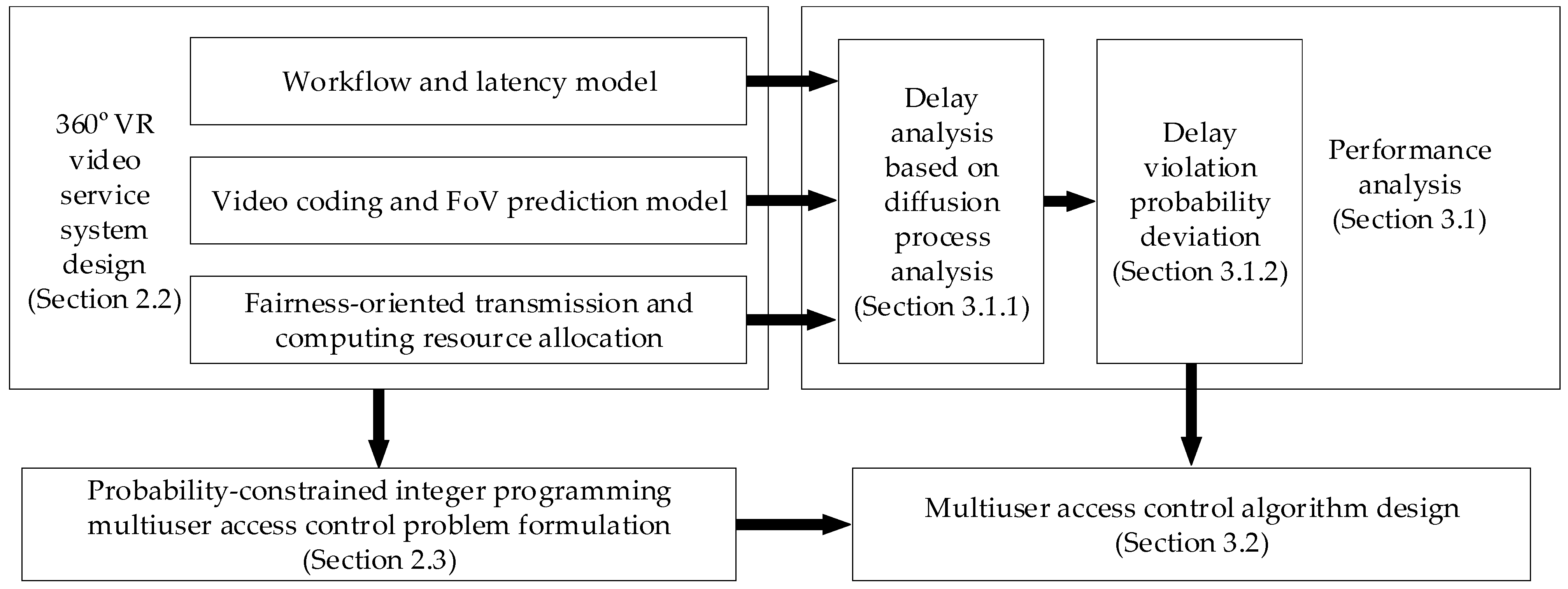

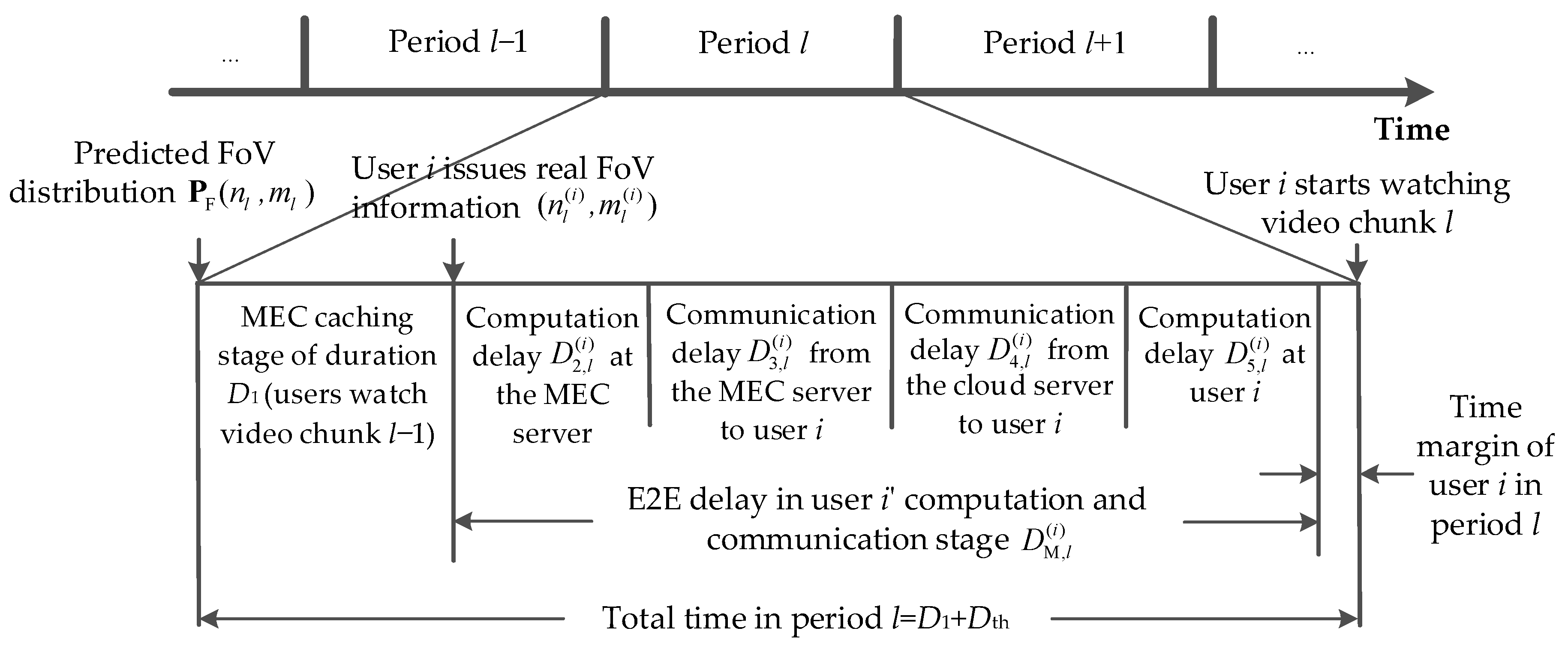
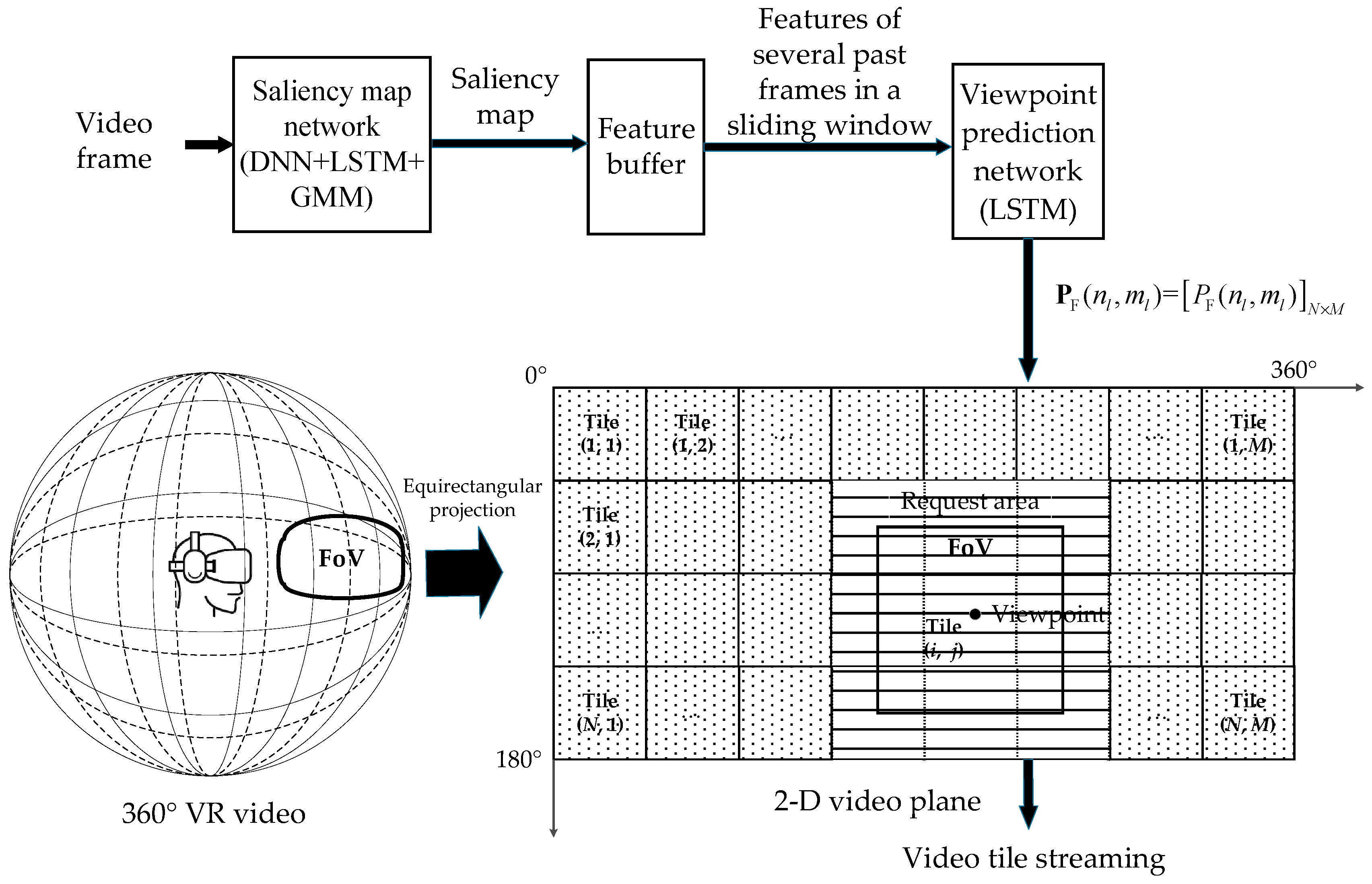
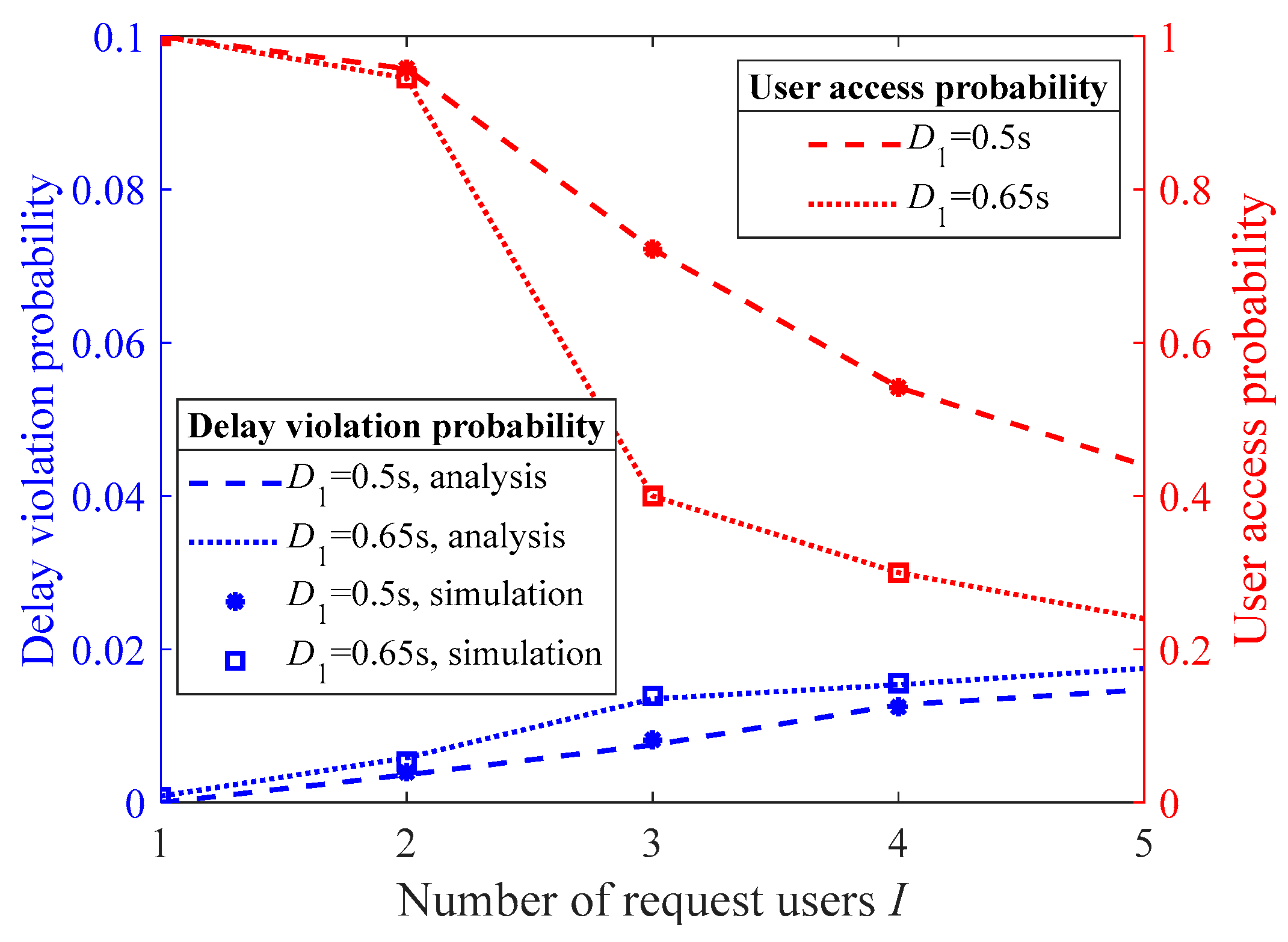
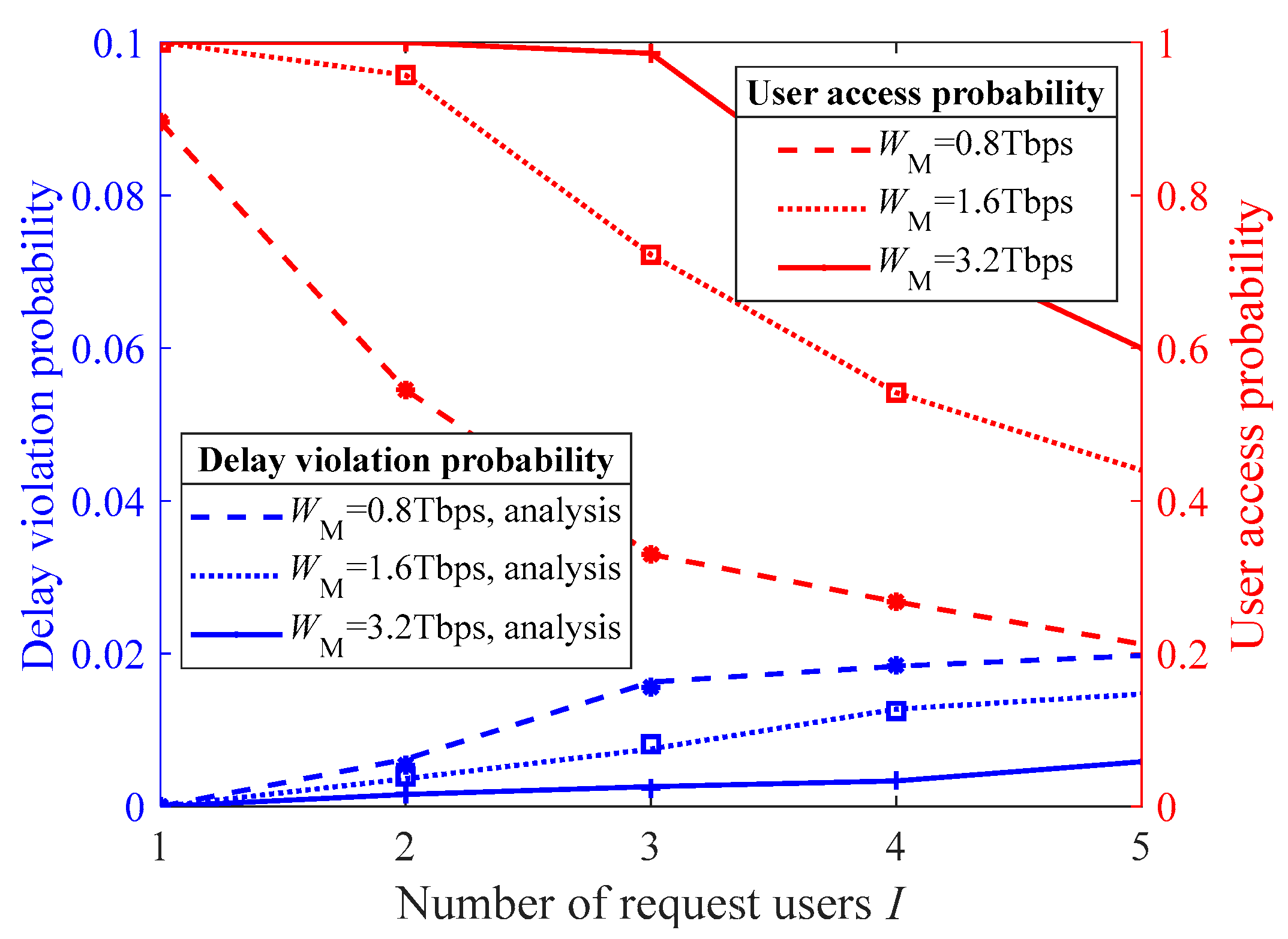

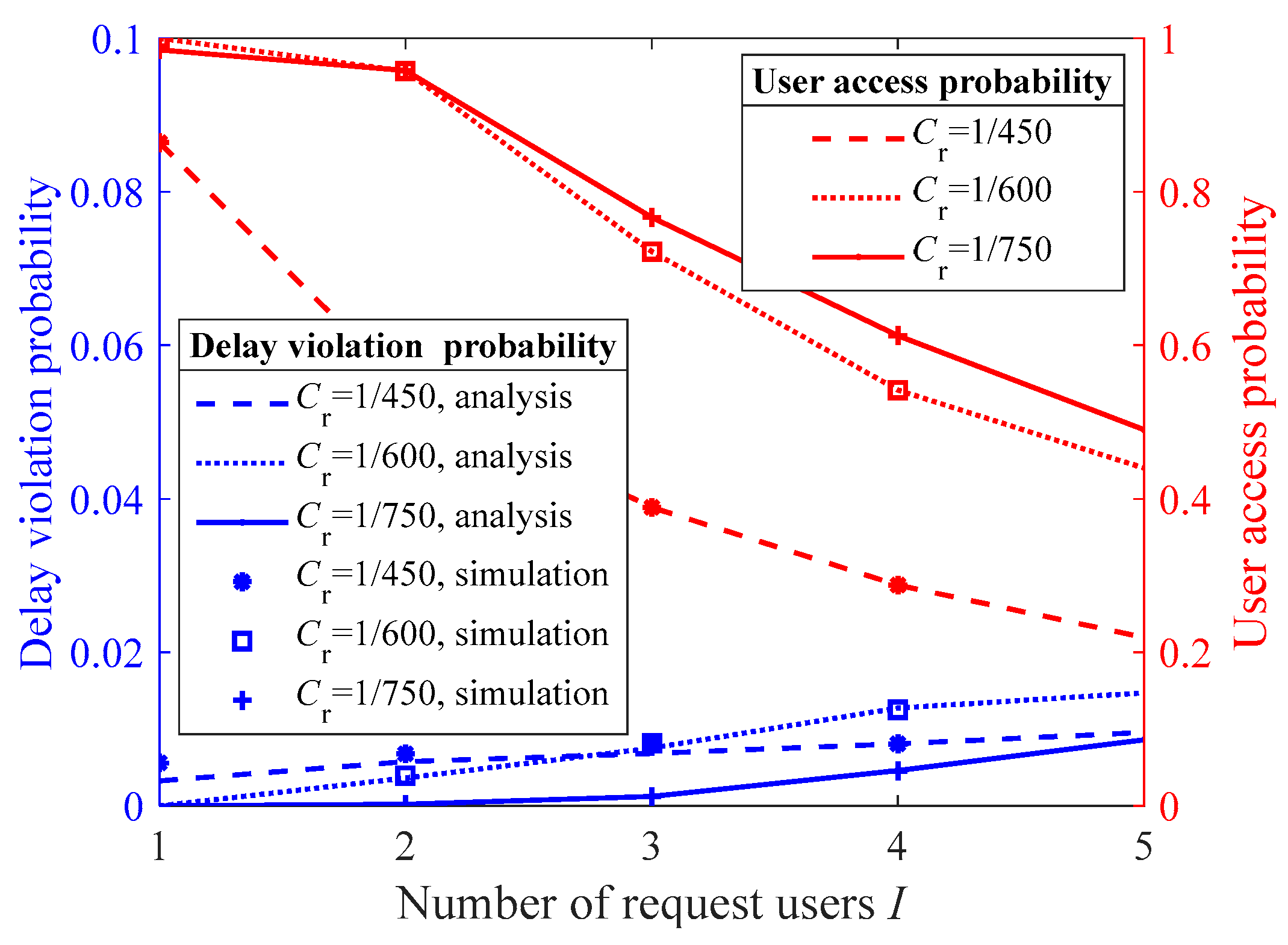
| Variable | Default Value |
|---|---|
| Tile number in the vertical and horizontal directions in a projected video plane | (8, 4) |
| Tile number in the vertical or horizontal direction in the FoV | 2 |
| Frame number per second of the video chunk | 60 fps |
| UDP packet size | 1460 bytes |
| Data size per tile per frame | 20 Mbit/frame/tile |
| Data size processed per second by the MEC server | 1.6 Tbps |
| Data size processed per second by the user | 40 Gbps |
| Data size changing ratio after computing offloading | 1.5 |
| Compression ratio of the video chunk | 1/600 |
| Typical actual caching time | 0.5 s |
| Preset E2E delay threshold | 0.02 s |
| Delay violation probability threshold | 0.02 |
| Transmission rate from the cloud server to the MEC server | [0,160] Mbps, uniform distribution |
| Transmit power of the MEC server-connected BS | 0.5 W |
| Bandwidth of the MEC server-connected BS | 100 MHz |
| Distance between the users and the BS | [15,20] m, uniform distribution |
| Path loss exponent | 3.5 |
| Noise power spectrum density | −174 dBm/Hz |
Disclaimer/Publisher’s Note: The statements, opinions and data contained in all publications are solely those of the individual author(s) and contributor(s) and not of MDPI and/or the editor(s). MDPI and/or the editor(s) disclaim responsibility for any injury to people or property resulting from any ideas, methods, instructions or products referred to in the content. |
© 2025 by the authors. Licensee MDPI, Basel, Switzerland. This article is an open access article distributed under the terms and conditions of the Creative Commons Attribution (CC BY) license (https://creativecommons.org/licenses/by/4.0/).
Share and Cite
Weng, Q.; Tang, Y.; Shan, H. Multiuser Access Control for 360° VR Video Service Systems Exploiting Proactive Caching and Mobile Edge Computing. Appl. Sci. 2025, 15, 4201. https://doi.org/10.3390/app15084201
Weng Q, Tang Y, Shan H. Multiuser Access Control for 360° VR Video Service Systems Exploiting Proactive Caching and Mobile Edge Computing. Applied Sciences. 2025; 15(8):4201. https://doi.org/10.3390/app15084201
Chicago/Turabian StyleWeng, Qiyan, Yijing Tang, and Hangguan Shan. 2025. "Multiuser Access Control for 360° VR Video Service Systems Exploiting Proactive Caching and Mobile Edge Computing" Applied Sciences 15, no. 8: 4201. https://doi.org/10.3390/app15084201
APA StyleWeng, Q., Tang, Y., & Shan, H. (2025). Multiuser Access Control for 360° VR Video Service Systems Exploiting Proactive Caching and Mobile Edge Computing. Applied Sciences, 15(8), 4201. https://doi.org/10.3390/app15084201






